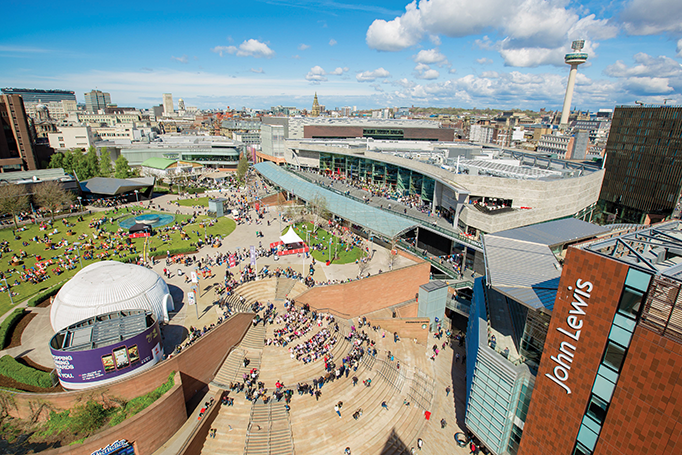
Starved in the 1930s, bombed all but flat in the 1940s and economically neglected until about 15 years ago, Liverpool was a colourful place to come from for much of the 20th century. “We were a savage little lot, Liverpool kids,” recalled native son Paul McCartney, sometime after he and his three friends had made their escape. That is all changing now, for the city’s economy in general and for retail in particular. Over the past seven years, this once troubled port city has catapulted from the 17th-largest retail market in the United Kingdom to the fifth-largest. Among the factors behind the renaissance are some £2 billion in redevelopment funds from the European Union, a few persistent city planners who insisted that an outdoor shopping mall would regenerate the downtown (this despite the fact that the city sees at a minimum some 10 rainy days every month, even in summer), and the unlikely fondness of a duke for things Liverpudlian.
Since the opening of Liverpool One in 2008, foot traffic and sales have grown every year. The 250,000-square-metre, 200-store, open-air shopping, leisure and residential complex drew 28 million visitors in 2015, according to owner-developer Grosvenor Group. Sales grew by 8.5 per cent in 2015. Several factors converged to make Liverpool One successful. First, city planners fought for an open, multilevel, mixed-use plan that would include a 40,000-square-metre rooftop park that would help revitalise the old city centre. Retailers were skeptical about this idea, but Liverpudlians in the main liked it, according to Trevor Skempton, an architect and urban designer who served as an advisor to the City Council between 2003 and 2009. “Liverpool’s climate is not harsh, but it is often damp and windy,” he said. “We conducted many wind-tunnel tests and fed the findings into the street layout. We also concluded that Liverpool people seemed happier to sit outside in cool and breezy weather than people in London.”
There was more. “It wasn’t a white box with doors at either end,” said Miles Dunnett, director of portfolio management at Grosvenor Group. “It was both open and engaging ... and that was fundamental to its success.”
And though there was only a single developer, a total of 25 design teams contributed to the project. The hope was that having different teams design different buildings would help “start an organic process of change and development” that would help the project age more gracefully than a conventional mall, according to Skempton.
Eighteen developers bid for the £1 billion project, but Grosvenor Group, one of the largest British property companies, convinced the city of its commitment to the concept. And yet the crucial factor in the end may have been the fact that the owner of Grosvenor Group — Gerald Cavendish Grosvenor, the Duke of Westminster — had a soft spot for the city.
In a 1995 interview on Desert Island Discs, a BBC interview program that asks celebrities to pick their 10 favourite records, the duke chose “Ferry ’Cross the Mersey,” by Gerry and the Pacemakers. The duke, a military man, attributed the choice to his “great fondness” for the Liverpudlians he once led in a squadron on the Isle of Skye, in Scotland.
In the Financial Times obituary for Grosvenor, who died in August at the age of 71, a Liverpool City Council member said that without the duke’s “personal commitment and faith in Liverpool,” it was unlikely the complex would have been built at all.